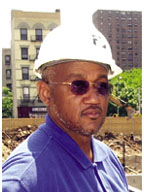|
Web Exclusives: Alumni Spotlight November 5, 2003:
A ‘green’ building
grows in Harlem The stucco and brick building that fills a city block just north of Manhattan’s Central Park may look much like the half dozen other apartment buildings under construction in lower Harlem, but it’s not. On Fifth Avenue, between 115th and 116th Streets, stands the latest product of developer Carlton A. Brown ’73, who builds affordable housing that connects urban African Americans to their cultural heritage and to the high-tech world. “How do we develop architecture that reflects who we are as a people and integrates that into the fabric of the 21st century?” he asks. “How do we rebuild a community in a way that encourages average people to take control?” Brown, who started Full Spectrum Building and Development, a Harlem-based real estate development company, in 1988 with coprincipal Walter Edwards, has found answers on many fronts. Brown believes building practices that use recyclable and recycled materials and energy-efficient designs — often called “green” practices — are one way of translating African architecture and values into a modern urban setting, a concern of his since his years at Princeton’s School of Architecture. The West African symbol for sturdiness will be a prominent decorative motif throughout the apartment building on Fifth Avenue. Brown also is committed to creating a space that is a portal to a broader world. “There is still a digital divide” between the black and Latino communities and nonminority communities, he explains. “To bridge it, you need the infrastructure.” He installed public terminals and fiber-optic cables, and there is wireless Internet access in the hallways and courtyard. The apartment building will give residents this neighborhood’s first taste of broadband. In his office, cable samples and a dusty white hard hat share space on his cluttered desk with the writings of W. E. B. DuBois. Brown and his partner have worked on other affordable housing projects in New York City, as well as on two hospitals in Brooklyn, a courthouse in Queens, and the lower Manhattan campus of Stuyvesant High School. Construction on the Fifth Avenue complex should be finished by
the end of the year. Partially financed by city, state, and federal
housing subsidies, 85 of the 128 condominium units are designated
for households with annual incomes between $53,000 and $103,000
— households that have been frozen out of the Manhattan housing
market because they make too much for traditional subsidized houses
but can’t afford market-rate homes. “This project demonstrates
that there is a different model of doing business in communities
like this one,” says Brown. “I hope it will help people
in Harlem to see themselves differently and to see their community
differently.” By Kristen Fountain ’96 Kristen Fountain is a freelance writer in New York City.
Home Current
Issue
Web Exclusives: Headlines - PawPlus - Features Tooke's Take - Varsity Typewriter - Inky Dinky Do Raising Kate - On the Campus - Comparative Life - More... PAW Online Archives - Print Archives - Advertising Info - Reader Services Search the Site - Contact PAW Princeton University - Alumni Links - Alumni Council - Your Class Secretary |
||


 The
building will use 40 percent less energy than a comparable urban
apartment complex, and will minimize the use of fossil fuels by
tapping into a nearby resource — the ground’s supply of
geothermal energy — for heating and air conditioning. The girders
will support walls made of composite plaster and synthetic plastics
with more than twice the insulating power of typical materials.
The
building will use 40 percent less energy than a comparable urban
apartment complex, and will minimize the use of fossil fuels by
tapping into a nearby resource — the ground’s supply of
geothermal energy — for heating and air conditioning. The girders
will support walls made of composite plaster and synthetic plastics
with more than twice the insulating power of typical materials.